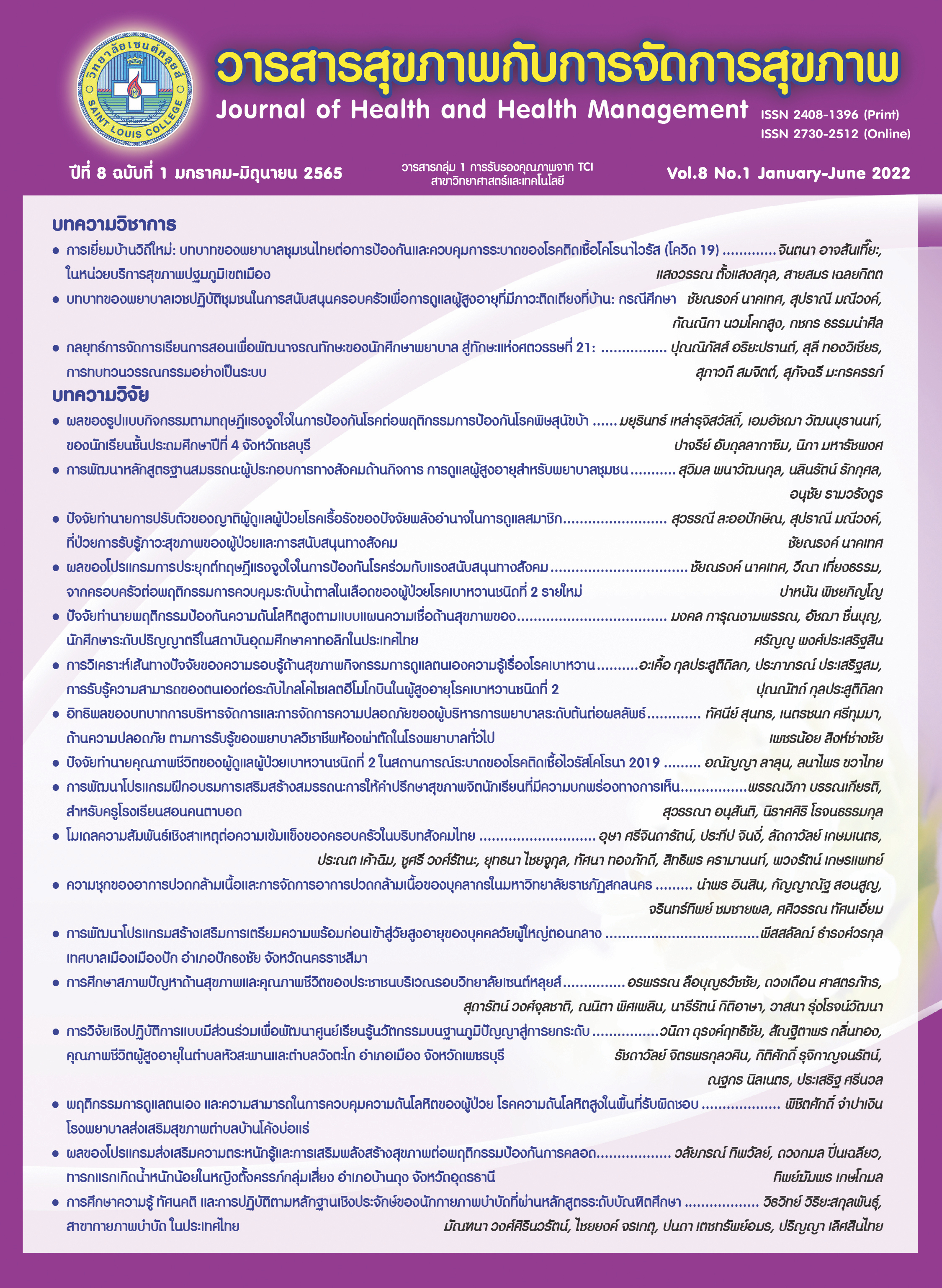The Effects of a Self-awareness Promotion and Health Empowerment Program on Preventive Behaviors regarding Low Birth Weight Infant Among High Risk Pregnant Women at Ban Dung District, Udon Thani Province
Keywords:
Self-awareness, Health Empowerment, Low Birth Weight Infant, Preventive Behavior, High-Risk Pregnant WomenAbstract
The purpose of this quasi-experimental research was to study the effects of a self-awareness promotion and health empowerment program on low-birth-weight infant preventive behaviors of high-risk pregnant women. The sample consisted of 60 pregnant women at risk of giving birth to low-birth-weight infants who attended the antenatal clinic at the Bandung Crown Prince Hospital network, during June to August 2021, selected from Low Birth weight rate exceeds the benchmark by purposive sampling, and they were divided into the experimental (30) and the comparative (30) groups. The research instruments included: 1) the program for self-awareness and health empowerment promotion. The activities comprised: (1) developing self-awareness (2) head empowerment (3) heart empowerment and (4) hand empowerment; and 2) a low-birth-weight infant preventive behaviors questionnaire, the content validity index (CVI) score of which was .99, and the reliability was .85 Data were analyzed by descriptive statistics and t-test.
The result revealed as follows. After receiving the program, low-birth-weight infant preventive behaviors of women in the experimental group were significantly better than before receiving the program (M = 3.67, SD = .12; M = 2.82, SD = .33), and their behavior was also better than those of women in the comparative group (M = 3.67, SD = .12; M = 3.07, SD = .18) (p < .001).
The result showed that the program for self-awareness and health empowerment promotion could help high-risk pregnant women improve preventive behaviors for low-birth-weight rate. Therefore, it is recommended to apply the program at antenatal clinic. This could enhance high risk pregnant women’s self-care behaviors and decrease low birth weight rat.
References
กรมรี แพงดี. (2558). การพัฒนาระบบการดูแลหญิงตั้งครรภ์ที่เสี่ยงต่อการคลอดทารกน้ำหนักน้อยโรงพยาบาลศรีสงคราม. วารสารการพยาบาลสุขภาพและการศึกษา, 3(1), 28-37.
กลุ่มการพยาบาล โรงพยาบาลสมเด็จพระยุพราชบ้านดุง.(2563). สรุปผลการดำเนินงานกลุ่มการพยาบาลโรงพยาบาลสมเด็จพระยุพราชบ้านดุง. อุดรธานี:โรงพยาบาลสมเด็จพระยุพราชบ้านดุง.
กลุ่มอนามัยแม่และเด็ก ศูนย์อนามัยที่ 7 อุบลราชธานี. (2558). คู่มือแนวทางการบริหารจัดการปัญหาทารกแรกเกิดน้ำหนักน้อยแบบมืออาชีพ.อุบลราชธานี: ศูนย์อนามัยที่ 7 อุบลราชธานี.
กองบริหารการสาธารณสุข กระทรวงสาธารณสุข.(2564). รายงาน Service Plan สาขาแม่และเด็ก. นนทบุรี: กระทรวงสาธารณสุข.
คณะแพทย์ศาสตร์ โรงพยาบาลรามาธิบดี มหาวิทยาลัยมหิดล. (2552). Empowerment กับการเสริมพลังสร้างสุขภาพ. นิตยสารหมอชาวบ้าน, 368. สืบค้นจาก https://www.doctor.or.th/article/detail/10287.
จิตต์ระพี บูรณศักดิ์, พุทธิราภรณ์ หังสวนัส, วิไล ไรวา, ฤดี ปุงบางกะดี่, และนัยนา แขดกิ่ง. (2563). ผลของโปรแกรมส่งเสริมสุขภาพสตรีตั้งครรภ์วัยรุ่นต่อน้ำหนักที่เพิ่มขึ้นตลอดการตั้งครรภ์และน้ำหนักทารกแรกเกิด. วารสารพยาบาลทหารบก, 21(2), 434-442.
ทิพสุดา นุ้ยแม้น. (2554). ผลของโปรแกรมการเสริมสร้างพลังอํานาจต่อพฤติกรรมการป้องกันการคลอดก่อนกําหนดในหญิงตั้งครรภ์วัยรุ่นมุสลิม(วิทยานิพนธ์ปริญญามหาบัณฑิต). มหาวิทยาลัยสงขลานครินทร์ม, สงขลา.
ปุญญพัฒน์ ไชยเมลล์, สมเกียรติยศ วรเดช, ภานุมาศ พิกุล, อนุชิต ชุมคง, สุทธิพงษ์ รักเล่ง, และพีรวัฒน์ มุททารัตน์. (2560). ปัจจัยที่มีผลต่อน้ำหนักทารกแรกคลอด อําเภอบางแก้ว จังหวัดพัทลุง. วารสารวิชาการสาธารณสุข, 26(3), 517-524.
ปิยะพร กองเงิน, วิไลลักษณ์ วงศ์อาษา, และกาญจนาสมบัติศิรินันท์. (2559). ผลของโปรแกรมเสริมสร้างพลังอำนาจแก่สตรีตั้งครรภ์ที่มีภาวะเสี่ยงในการคลอดก่อนกำหนดและสามีต่อพฤติกรรมส่งเสริมสุขภาพ จำนวนของการคลอดก่อนกําหนด และทารกแรกเกิดน้ำหนักน้อย. วารสารสภาการพยาบาล, 31(3), 67-82.
สำนักงานสาธารณสุขจังหวัดอุดรธานี. (2564). ฐานข้อมูล HDC ร้อยละทารกแรกเกิดน้ำหนักน้อยกว่า 2,500 กรัม. สืบค้นจาก https://udn.hdc.moph.go.th/hdc/main/index.php.
สุนทร ฮ้อเผ่าพันธ์. (2558). Newborn. กรุงเทพ ฯ: ราชวิทยาลัยกุมารแพทย์แห่งประเทศไทย.
รุ่งนภา รู้ชอบ, นิตยา สินสุกใส, วรรณา พาหุวัฒนกร,และดิฐกานต์ บริบูรณ์หิรัญสาร. (2558). ปัจจัยทำนายการคลอดทารกแรกเกิดน้ำหนักน้อย.วารสารพยาบาลศาสตร์, 33(3), 18-29.
วรัณญา เก้าเอี้ยน. (2563). การศึกษาปัจจัยเสี่ยงของมารดาที่มีผลต่อการคลอดทารกแรกเกิดน้ำหนักน้อยในโรงพยาบาลหัวยอด จังหวัดตรัง. วารสารวิชาการแพทย์เขต 11, 34(3), 63-72.
วราภรณ์ แสงทวีสิน, ศุภวัชร บุญกษิดิ์เดช, วิบูลย์ กาญจนพัฒนกุล, และสุนทร ฮ้อเผ่าพันธุ์. (2557).ทารกคลอดก่อนกำหนด (Preterm). กรุงเทพฯ: สถาบันสุขภาพเด็กแห่งชาติมหาราชินี.
อรพินท์ กอสนาน. (2556). ผลต่อการเกิดทารกแรกเกิดน้ำหนักน้อยในโรงพยาบาลบางน้ำเปรี้ยว.ฉะเชิงเทรา. วารสารศูนย์การศึกษาแพทย์ศาสตร์คลินิกโรงพยาบาลพระปกเกล้า, 30(4), 287-299.
Cunningham, F.G., Leveno, K.J., Bloom, S.L. ... and Jeanne, S. (2014). Williams obstetrics (24th ed.). New York: McGraw Hill Education.
Duval, T.S. & Wicklund, R.A. (1982). A theory of objective self-awareness. New York: Academic
Mathewson, K., Schmidt, L., & Van, L.R. (2017). Extremely low birth weight babies at higher risk of mental health problems. Midwives, 20(2), 38-39.
Pillitteri, A. (2013). Maternal and Child Health Nursing: Care of the childbearing and childrearing family (7th ed.). Philadelphia: Lippincott Williams & Wilkins.
United Nations Children’s Fund and World Health Organization. (2019). UNICEF-WHO Low birth weight estimates: Levels and trends 2000–2015. Geneva: Switzerland.
Downloads
Published
How to Cite
Issue
Section
License
Copyright (c) 2022 Journal of health and health management

This work is licensed under a Creative Commons Attribution-NonCommercial-NoDerivatives 4.0 International License.




